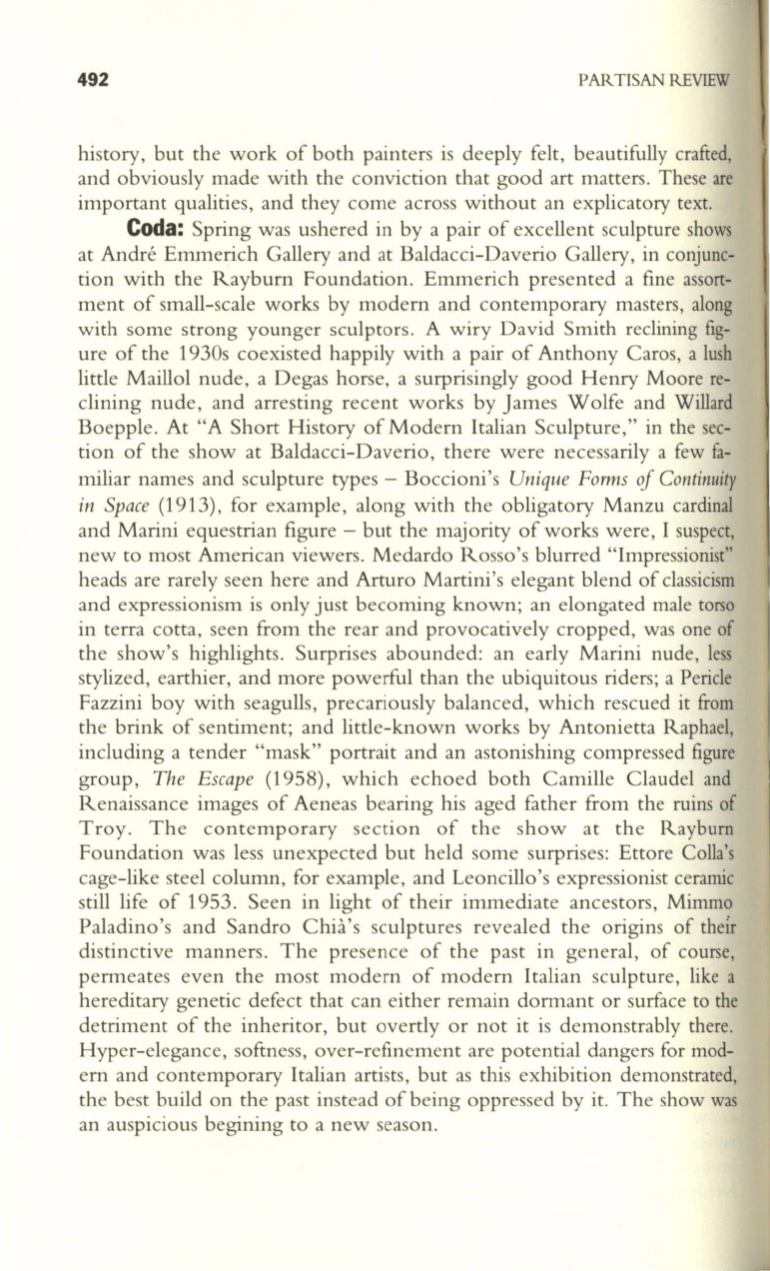
492
PARTISAN REVIEW
history, but the work of both painters is deeply felt, beautifully crafted,
and obviously made with the conviction that good art matters. These are
important qualities, and they come across without an explicatory text.
Coda:
Spring was ushered in by a pair of excellent sculpture shows
at Andre Emmerich Gallery and at Baldacci-Daverio Gallery, in conjunc–
tion with the Rayburn Foundation. Emmerich presented a fine assort–
ment of small-scale works by modern and contemporary masters, along
with some strong younger sculptors. A wiry David Smith reclining fig–
ure of the 1930s coexisted happily with a pair of Anthony Caros, a lush
little Maillol nude, a Degas horse, a surprisingly good Henry Moore re–
clining nude, and arresting recent works by James Wolfe and Willard
Boepple. At "A Short History of Modern Italian Sculpture," in the sec–
tion of the show at Baldacci-Daverio, there were necessarily a few fa–
miliar names and sculpture types - Boccioni's
Unique Forms oj Continuity
in Space
(1913), for example, along with the obligatory Manzu cardinal
and Marini equestrian figure - but the majority of works were, I suspect,
new to most American viewers. Medardo Rosso's blurred "Impressionist"
heads are rarely seen here and Arturo Martini's elegant blend of classicism
and expressionism is only just becoming known; an elongated male torso
in terra cotta, seen from the rear and provocatively cropped, was one of
the show's highlights. Surprises abounded: an early Marini nude, less
stylized, earthier, and more powerful than the ubiquitous riders; a Pericle
Fazzini boy with seagulls, precariously balanced, which rescued it from
the brink of sentiment; and little-known works by Antonietta Raphael,
including a tender "mask" portrait and an astonishing compressed figure
group,
The Escape
(1958), which echoed both Camille Claude! and
Renaissance images of Aeneas bearing his aged father from the ruins of
Troy. The contemporary section of the show at the Rayburn
Foundation was less unexpected but held some surprises: Ettore Colla's
cage-like steel column, for example, and Leoncillo's expressionist ceramic
still life of 1953. Seen in light of their immediate ancestors, Mirnrno
Paladino's and Sandro Chia's sculptures revealed the origins of their
distinctive manners. The presence of the past in general, of course,
permeates even the most modern of modern Italian sculpture, like a
hereditary genetic defect that can either remain dormant or surface to the
detriment of the inheritor, but overtly or not it is demonstrably there.
Hyper-elegance, softness, over-refinement are potential dangers for mod–
ern and contemporary Italian artists, but as this exhibition demonstrated,
the best build on the past instead of being oppressed by it. The show was
an auspicious begining to a new season.


